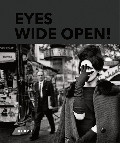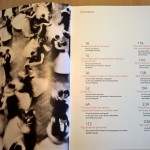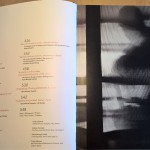100 Years of Leica Photography.

Hans-Michael Koetzle (Ed.) Translated from German into English by Alexandra Cox. ©2015 Kehrer Verlag Heidelberg Berlin, artists, photographers and authors [and translator!]. ISBN 978-3-86828-530-7
With the exception of the chapter by Peter Hamilton, all chapters (and all notes, credits, biography, thanks) translated from German into English by Alexandra Cox. To read the Contents, click on the thumbnails below.
The first and final paragraph of the Preface, by Hans-Michael Koetzle:
“Has Barnacle still got his Leica?”
The Leica is not mentioned once. Not a word in his book Mythologies, first published in 1957–and this is despite the author’s rumored marked affinity for photography. At any rate, his slim volume La Chambre claire bears witness to intensive reflection on the medium and is not by chance among the most-cited titles when photography is talked about. But Roland Barthes, the great structural philosopher, was no encyclopedist. And if, in his Mythologies, he leaves the Leica unmentioned among Einstein’s brain and the new Citroën, Garbo’s face, and “The Family of Man”, he in no way does so out of ignorance. Barthes’s concern in his book was not to provide a maximally comprehensive enumeration of everyday myths in whatever form they may be, but to describe a paradigm within the boundaries of which the 1914-designed camera would very likely have found a place. There is no doubt, the camera from the Leitz company is one of the 20th century’s landmark inventions. Its appearance from 1925 onward revolutionized photography–technologically, aesthetically, culturally. For not a few people it was and is symbolic–pars pro toto–of a “New Photography” since the 20s–of a “New Vision”–of a new perception of the world. The writer Albrecht Goes attended to the topic from the culture-critical perspective and at the same time–knowingly or en passant, as it were– underlined the Leica’s significance for our worldview: “You know the young man I mean,” he writes in his Gespräch über die Photographie (1938), “the one with his camera hanging on the brown leather strap at his chest. Lord, that is the Polyphemus of the twentieth century, the true Cyclops. Smash his Leica, quite without odyssean cruelty, and the man is blind.”
…
“Has Barnacle still got his Leica?”, Georges Simenon has the detective ask his employee in the novel Maigret on the Defensive. “He’d sooner be parted from his wife than from his camera…”. The Leica, its main features designed in 1914, its “baptism” and introduction occurring in 1925, was, this much is certain, photography’s response to a new, fast-paced era. In addition it was beautiful, perfectly formed. Contemporary reviews spoke of a “jewelry item”. There is not a single Leica photographer who did not nurture an ardent relationship to his camera. First and foremost of these was Henri Cartier-Bresson, the “eye of the century”. He never gave up on the Leica; he once stated, “every attempt in another direction has brought me back to it. I’m not saying that what applies for one person must apply for the next. For me, it is simply the only camera that I will consider.” There is no doubt: the Leica was and is equally technological masterpiece and object of desire, if not to say: fetish. Above all, though, it is a tool for creating images: large images, quiet images, surprising images, devastating, striking, simply beautiful, or visually complex images. Images that document, inform, unsettle, emotionalize–definitely images without which our optical culture would be decidedly poorer. Ultimately, that is what it is about–in our book and generally.
©2015 Kehrer Verlag Heidelberg Berlin and author [and translator!].
The first paragraphs from:
“The Leica is the only camera a motor enthusiast can possibly need” 35 mm and photo avant-garde in the years prior to the Second World War, by Hans-Michael Koetzle
Photographs from the period after 1930 show him as a half-length figure sitting at a simple desk, surrounded by workpieces, camera prototypes, lenses. He always wears a foreman’s white coat. And when he looks into the camera, his gaze expresses self-confidence, but also a certain shyness coupled with a modesty that cannot be overlooked. Who was Oskar Barnack, born in 1879 in Lynow near Berlin, from 1911 master of the experimental department at Leitz Wetzlar, and known as the creator of the Leica? Contemporaries describe him as silent and introverted, a “shrewd, highly gifted”[i] person, who enjoyed listening to music, played chess brilliantly, and took a thoroughly realistic view of the world, without, however, taking any interest in politics.[ii] He shows a corresponding reticence in written matters. In other words: Oskar Barnack may have been an exceptional tinkerer, an ingenious design engineer, and a farsighted inventor–a master of the pen he was not. Search, for instance, for abundantly worded correspondence that may possibly provide information about the birth of the “compact camera” he helped on its way in 1914, and you will be hunting in vain. Nothing approximating an autobiography was left behind by the technician, who was yanked out of professional life at age 56. The instructions to his employees in design engineering, handed down on innumerous squared notelets, are almost cryptic. Even the entries in the preserved, legendary shop book could not have turned out more terse. “Lilliput camera with cine film ready” is written, for example, in March 1914. Five months later the entry was limited to a single word, “War,”[iii] beneath it a resolute line, leaving it open to speculation whether and in what manner Oskar Barnack advanced his invention in the years up to 1918.
If he were here to talk to, Leica historians interested in photo technology in particular would have all sorts of things to put forward–questions which even the few texts written by Barnack himself are unable to clear out of the way, including “How the Leica was created” in the form of a 141-line retrospective, published for the first time in Issue 1 of Die Leica. This magazine was founded by its director Curt Emmermann in 1931 and was a new kind of professional magazine aimed at all “who work with the Leica, be they amateurs, professional photographers, reporters, scientists, researchers, technicians, athletes, or just happy snappers.”[iv] Barnack’s text has been repeatedly reproduced, cited, and commented on as a source.[v] It is a piece of prose written from a distance of more than two and a half decades, to write which–so it appears–the author had to be positively persuaded. “Embarking on historical retrospectives,” Barnack wrote right at the start of his comments, “was not my intention at first; perhaps that could come when there was more time.”[vi] Barnack’s terse tour d’horizon, which begins with a look at traditional camera practice “with the solid plates and the splendid roll films” and ends with a eulogy to the Leica, reveals many things, but also conceals plenty. Had Barnack already been working on a compact camera in Jena, so while he was still at Zeiss?[vii] Was he familiar with the comparable designs – at least in the use of reeled cine film–by Lleo (1908), for instance, or Moses (1914), or Maroniez (1923)? What type of viewfinder did Oskar Barnack use in his first camera? And what lens?–These questions, as Ulf Richter for instance emphasizes regretfully, are answered neither by the shop book nor by the cited retrospective.[viii]
(Endnotes not reproduced here on this website)
©2015 Kehrer Verlag Heidelberg Berlin and author [and translator!].
Paragraphs from:
“You’d have to dance first” The painter Alfons Walde and photography as prelude, by Rebekka Reuter
Color for amateurs had already been in existence since 1907, thanks to the autochrome plates of Auguste and Louis Lumière. However, the modern color equipment that was introduced in the mid 30s popularized the medium of color photography in a particular way, even if, for war reasons, it was some time before it was able to assert itself. The new Agfacolor film, available specifically for compact cameras, meant comparatively uncomplicated use and enabled Leica photographer Walde the albeit relatively expensive, but simple and spontaneous use of color as a visual means. This world of colors–more than 20,000 glass slides, arranged in boxes and crates[i]–is to be examined against the background of those times, of both the social and the personal circumstances that produced it.
After the loss of Southern Tyrol, a bitter and painful one for the patriotic Walde, the painter felt the 20s to be an awakening into an era of hope and joie de vivre. The first chic winter guests–aristocrats, intellects, artists–took to the Kitzbühel stage; ladies from across the world posed in the snow for him. In this environment there prevailed a climate of liberty which, in the face of the political situation as the 30s progressed, shifted increasingly into the private sphere. Walde’s chalet on the Hahnenkamm, built to his plans in 1929, was one such stronghold of permissiveness, a “scene of resistance,”[ii] where a boisterous, sensual, colorful existence was celebrated. The artist’s openness–specifically to erotic experiments beyond monogamous, strictly bourgeois conventions–is reflected somewhat in his nude photography, but awareness of this comes more with knowledge of Walde’s relationship to women than in what is depicted itself, which, for all its eccentricity, is characterized by a peculiarly cranky conservativeness. The impression of the slightly bizarre may be forced by the permanent citing and falling flat of art history’s classic poses, combined with props that say more about the photographer’s predilections than they actually reveal in visual language about themselves. In addition to typical fetishes like stockings, garters, stilettos, and chiffons, recurring symbols of domesticity can be found in the photographic arrangements – for instance a fat red candle in a round stand which, apart from its unmistakable phallic symbolism, above all provides a dot of color and from that point of view, like the lengths of fabric abundantly deployed mainly in blue, red, and green, suggests, at least, the artist’s interest in sounding out the potentials of color photography.
Sometimes sultry, sometimes refreshing, Walde’s slides exude an intimate atmosphere, which presumably is due to the fact that his wives, lovers, and admirers posed as models for him.[iii] The appearances of these women, their anticipation of the image in putting their bodies on show, can be taken as classic examples of the gender-specific differentiation of the gaze, of the dichotomy of gazing male subject on the one hand, and of observed female object on the other. In other words, Walde’s female protagonists set themselves up as a “sight”[iv] par excellence, but as such they do not appear passively subjected to scrutiny. These are lusty participants in a sometimes playfully coquettish, but fundamentally consensual duel between photographer and model, which may be described as foreplay, and literally as a prelude, to Walde’s painted art as well.
Occasionally, such scenarios were painted using a grid system strictly according to the photographic template;[v] realization in paint was mostly, however, free and open in design, design which, though it integrated defined shapes and colors here and there, generally abstracted actual models, transposing their faces into roles and masks. Thus, from the early striking pastels to the late, more coarse than dynamic-looking nudes, he created countless works on paper using graphite, tempera, or oil that never really took off but were received only in expert circles as “accompanying music”[vi] to his official oeuvre. The artist himself took care of a heavily symbolic fusion of his two topoi, of femininity and of mountain landscape, with his Winterträume (Winter Dreams–circa 1925, thus titled by his descendants), in which the curvatures of the snow are transformed as if by a magic touch into naked female bodies.[vii]
Also and especially as a photographer, Walde aggressively staged his desires at the same time. Visually, his distinctly voyeuristic traits are probably nowhere so explicitly brought out as in a series of pornographic black-and-white photographs that shows his wife Lily and a friend of the couple in different poses during the sexual act. That this setting particularly stimulated and preoccupied Walde is illustrated by the richly detailed transposition of three of these photographs into large-format pastels (circa 1932). His Candaulism found a written counterpart in erotic and pornographic letters. Wildly telling stories, with astonishing verve the artist imagined himself in the roles of watcher and choreographer simultaneously, when for instance he demanded of his lover and her “beau”: “You’d have to dance first (at the chalet) alone and with spectator. You’d have to be terribly horny and in love and kiss him rabidly […]. I’ll be sitting with a cigar in the armchair”–camera casually to hand, it may be inferred–aroused “at the sight of the naked bodies, which roll and embrace […].”[viii]
(Endnotes not reproduced here on this website)
©2015 Kehrer Verlag Heidelberg Berlin and author [and translator!].
It’s not possible to reproduce many extracts from this very large book without causing excessive cluttering, but here’s one more!
The first paragraphs from:
“Here’s one for all time!” On the age of the great magazines, of great stories, and of really great pictures, by Michael Ebert
The Second World War was over and, if people dreamed of anything for a moment, it was of an age of peace, of understanding, of an age of humanity that would now dawn. Such an age, however, would soon prove to be a Utopia. The fact is, the second Golden Age of photojournalism was characterized many more times over by wars and conflicts than the first one in the 20s and early 30s had been.
The Second World War’s very final days had given rise to two photographic icons which can be found in almost every history book today and which are strikingly similar motif-wise. First, Yevgeny Khaldei’s Raising the Red Flag on the Reichstag–a piece of staging (never denied by its maker) which had been taken days after the clashes and, what is more, had been elaborately post-edited as well. Khaldei never had a problem with this; he did not view himself as an objective journalist, but as a propagandist who used a camera.[i] This is entirely in contrast to Joe Rosenthal from the US news agency Associated Press (AP), to whom we are indebted for the other picture of the century: Raising the flag on Mount Suribachi. Rosenthal had to live his whole life with the accusation that he reconstructed his photo of the conquering of Iwo Jima: it was not even the first flag, it is said again and again. This fable seems as indestructible as the Marine Corps War Memorial, carved after the picture, in Washington–incidentally the biggest bronze memorial in the world.[ii]
A legend’s ineffaceability does not make it truer. At the same time the magazine Life had already detailed the way things really had been in its March 26, 1945 issue:[iii] the commanding colonel had found the first flag too small and it was now to be replaced by a bigger one.[iv] And this happened just as Joe Rosenthal had climbed the hill accompanied by army cameraman Bill Genaust.[v] Rosenthal did what he was being paid for: he photographed six Marines who were laboriously heaving up a water pipe on which the stars and stripes were fluttering. In doing so he defined no less than the archetype of eternal photo icons, the most significant of which were created during the second Golden Age of photojournalism. “Here’s one for all time!” AP picture editor John Bodkin let slip as the photo slowly appeared in the developer.[vi] The uberphoto garnered Rosenthal the Pulitzer Prize, but also brought him envy and suspicion.[vii]
Hall of Fame of photojournalism
Now the weapons were finally silent, and the global language of photography was to help to ensure that things stayed that way: that was at least the vision of Edward Steichen, photo curator at New York’s Museum of Modern Art. During the war Steichen commanded the photo department of the US Navy in the rank of captain. With dramatically stylized images he supported the combat against the Japanese Empire to the best of his ability, but his interest lay in peace. In 1951 he devised his exhibition “The Family of Man.” The ambition, no more and no less, was to demonstrate, with the conditio humana in mind, that all people are alike, and thereby to transform hatred into fondness and make the world a better place.[viii] For this Steichen viewed countless thousands of photos by hundreds of photographers. When the exhibition was finally ready in 1955, peace was on virtually no-one’s lips any more and Steichen drew criticism for his worldview, chiefly from intellectuals. They had long since become disillusioned by the raw Cold War climate. Unmoved by this, more than 10 million[ix] people worldwide visited “The Family of Man.” The exhibition thus made a considerable contribution to ensuring that the 20th century definitively became a century of images.
The success of “The Family of Man” was simultaneously the success of “photographie humaniste,” which had been elected a guiding principle by an exquisite group of European photographers: Robert Capa, Henri Cartier-Bresson, David (Chim) Seymour, and George Rodger. In 1947 they founded the Magnum agency, which they called a cooperative and which was meant to become a kind of Utopia in the press landscape. This experiment exists to this day and is tantamount to a “Hall of Fame” of photojournalism. The idea was to give photographers new self-confidence in a community of colleagues; at the same time, though, the aim was also to create a counterweight to the dominant editorial teams and to organize the continued exploitation of photoreportages. Capa became the agency’s motor and spiritus rector. The native Hungarian was already a star at the time and matched the zeitgeist perfectly–a charming womanizer and bohemian, a captivator in the best sense, for whom it was child’s play to win the most talented young photographers for Magnum. The first new member to sign a contract with Magnum–in September 1948–was Werner Bischof. The Swiss photographer had been working professionally already since 1939, among others for DU–founded in 1941 as a culture magazine and still a platform for outstanding photography today.
(Endnotes not reproduced here on this website)
©2015 Kehrer Verlag Heidelberg Berlin and author [and translator!].


